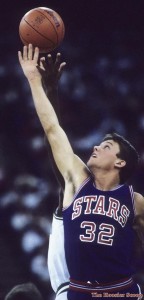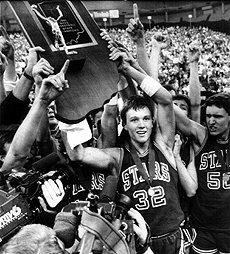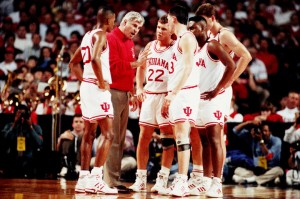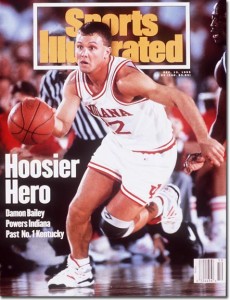Past Imperfect: The Boy From Bedford
Posted by JWeill on February 10th, 2011Past Imperfect is a series focusing on the history of the game. Every Thursday, RTC contributor JL Weill (@AgonicaBoss | Email) highlights some piece of historical arcana that may (or may not) be relevant to today’s college basketball landscape. This week: the boy wonder Damon Bailey.
It doesn’t seem odd to us these days to see kids touched by the grace of the basketball Gods at 14 and 15 years old, kids deemed saviors by followers of the game and coaches, too. Oh, sure, we act aghast that a coach would offer a scholarship to a 14-year-old, then we applaud and massively reward coaches who reel in the top talent, the very kids who have generally been courted since they were in junior high. But years ago, this still seemed something beyond the game. In an era where going pro early meant leaving as a junior, identifying and — more so — publicizing the exploits of a pre-high school-age player came across as crass, perhaps even unethical. My how times change.
Ignoring for the moment a decade in which high school kids were handed the keys to the NBA castle, we have become so inured to the phenomenon of the phenom, so accustomed to the custom of the precocious freshman, we no longer think it all that strange that kids are being identified and categorized and ranked and evaluated at an early age. It seems, well, normal. And why shouldn’t it? Last season, two freshmen were named first-team All-America, and this season many feel another freshman, Jared Sullinger, could be Player of the Year. That’s not a problem. That’s just the way it is.
Two decades ago, freshmen were certainly scrutinized, and plenty saw of minutes. The Fab Five entered college in the fall of 1991 and changed the way freshmen were regarded forever. But even then, in the pre-dawn of the age of the freshman, tapping a kid as a star before he has even settled on a high school seemed somehow too much. And then there was Damon Bailey.
* * *
The story came straight out of the big screen: Once upon a time in Indiana, a blond-haired kid with a square jaw and a jump shot is called one of the best basketball players in America. He outmuscles bigger players and out-quicks smaller ones. He can pass, he can score. He is tough-nosed and plays aggressive face-up defense and knows how to win. In fact, his team is undefeated two years in a row. A legendary college coach comes to watch him work. Of course, the star of this story has never played a minute of high school basketball. This is because he is still in the eighth grade.
The classic basketball film Hoosiers came out in 1986. A year later, Damon Bailey echoed the ethos of that iconic movie when he arrived on the basketball scene with a flourish, thanks to a writer and a Hall of Fame coach. That Bailey had little in particular to do with his fame is a story in and of itself – a script within a script.
This script shows Indiana University head coach Bob Knight – by that time a three time national champion and the physical embodiment of Hoosier basketball – coming to see this 14-year-old kid play, standing at the door with his arms folded as commotion abounds due to his very presence. Afterwards, Knight, in a bit of Knightian hyperbole, states to his coaches that the kid is better than the guards Indiana has at the time. Then the writer reports it, and the legend begins.
In an era before the Internet, before fans could see clips of high school stars — heck, junior high stars – dunking and juking and sweet shooting past and over outclassed opponents, it took a lot to get noticed by the national sports media. Yes, there were Five-Star Camps and recruit ranking services and nationally recognized recruiting analysts. It’s big-time basketball, so of course there was. But it wasn’t quite yet the sport unto itself it is now, and, more importantly, it wasn’t something readily accessible to the general college basketball fan, save possibly a back-page mention in a Street & Smith’s or Blue Ribbon preseason magazine.
But Damon Bailey got noticed. That’s what Bobby Knight coming to your junior high game can do for you. It’s also because Bailey’s presence (and Knight’s) was featured prominently in John Feinstein’s bestselling yearlong excursion into an Indiana Hoosiers season, A Season on the Brink. That’s where the story of Knight’s visit to the tiny gym in Shawswick first came to light.
And it’s also because Bailey was very, very good at basketball. But if the story of Damon Bailey was just making itself known to fans of the college game outside Indiana, the legend of Damon Bailey was already well under way in Hoosier-land.
* * *
Bedford, Indiana, is not a big place. Just 14,000 people or so. It’s the kind of place where being a good basketball player is a big deal. And it’s the kind of place where being a basketball legend is the biggest deal there can be. Damon Bailey was as big a deal as Bedford had ever produced. In November of 1986, no less than Sports Illustrated tabbed Bailey the country’s best ninth-grade hoopster. Add this to the praise afforded him by Coach Knight, and you can imagine that it would be tough for any kid to live up to that kind of hype. And it was, and it is. But that’s what Bailey did, beginning right away as a high school freshman.
Bailey made his presence felt immediately, leading Bedford North Lawrence High School to the state Final Four as a freshman, averaging over 23 points a game in the process. He would be named All-State that year. Then he would do it again the next year. And then again. And to top himself, all Bailey did as a senior was march the Stars to the Indiana state championship, scoring 30 points — including his team’s final 11 — in a storybook 63-60 come-from-behind win in the 1990 title game. Their opponent was undefeated. None of Bailey’s teammates were taller than 6’3”.
All told, the boy legend would be a four-time All-State pick, score a state-record 3,134 points and be named Mr. Basketball. For all of this, Bailey would also be recognized nationally, earning McDonald’s All-American honors alongside names like Grant Hill, Shawn Bradley and Ed O’Bannon. Of course, for Bailey, it wasn’t unusual to be nationally recognized. For him, it started years before. But the stage was about to get bigger, and louder. His high school days over, Bailey would be stepping into Bob Knight’s practices. As Bailey told reporters after winning the state crown: “Now, I’m his boy.” And that’s where the big-screen, feel-good story would finally hit some rough patches.
* * *
Now, finally, Hoosiers fans everywhere would get to see their wonder boy in action. But if the script called for Bailey to go to Big State U. and continue his dominance unabated, the writer forgot about a few key factors: namely, Indiana University is no Bedford North Lawrence. First of all, Bailey had the ill-fortune, if you can call it that, of arriving – big rep in tow – the year after a deep, talented recruiting class, meaning that despite his stature in the state, practically speaking the wonder boy would have to earn his PT like everyone else, and against some of the best of the best. Not surprisingly, Bailey struggled at times.
Like North Carolina’s Harrison Barnes this season, Bailey even received consideration for All-American status, despite having never played a minute of college ball. That always sits well with your older teammates, not to mention your crusty, Hall of Fame coach. For Knight, the biggest issue was not with Bailey’s talent but rather with his effort and focus. Coachspeak, to be sure, but also a key ingredient in any collegiate star’s ultimate success.
Up and down throughout his first three seasons, Bailey managed just 11.3 points a game. Not bad, but hardly the stuff of legends. Still, Hoosier fans remained loyal to their boy. To wit, Indiana’s athletic offices got more requests for paraphernalia and autographs for Bailey than any of the team’s other stars, including national Player of the Year Calbert Cheaney.
But by the time he was a senior, some of the team’s biggest stars were gone. It was Bailey’s turn to be the man, and he did what basketball legends always do: he answered the call the best he could. The boy from Bedford helped lead Indiana to 21 wins and the Sweet 16 as a senior. No, not exactly Steve Alford, but not Delray Brooks, either.
While Bailey’s career numbers at Indiana don’t jump out at you — 13.2 points, 3.5 rebounds and 3.6 assists per outing – it should be remembered how few prep legends really turn into what everyone expects them to. And in Bailey’s case, it wasn’t just the pressures of performing day-in, day-out — something any player struggles with. He also had the weight of a state’s collective eyes on him at all times. And he’d had that omnipresent voyeur since the eighth grade. That Bailey finished sixth all-time on the Indiana scoring list, played in one Final Four, was part of 86 wins and was named first-team all-Big Ten and third-team All-American should be lauded, not dismissed. And yet, in this age, it seems there’s always another scene to be played out, another level to conquer. In the script we usually know, the hero can’t just fade away. But in real life, sometimes, heroes are just regular, extraordinary people who achieve big things. And, big things achieved, Damon Bailey was about to reach the end of the basketball road.
* * *
Since leaving Bedford, basketball had been, for Bailey, more than a game. It had been like a job. Playing for Bob Knight, playing for the whole state of Indiana, was a lot. Good wasn’t enough. You had to be great. And Bailey wasn’t great often enough for some folks. That’s why it started to feel like a job. Then, not that long after being drafted by the home-state Indiana Pacers in the second round of the 1994 NBA Draft, in reality it actually ceased to be one. After sitting out his rookie year thanks to a pair of rebuilt knees, and facing a cadre of would-be Pacers point guards, the boy legend Bailey was released.
But Bailey wasn’t just a basketball God. He was also a kid from a hamlet on the outskirts of Bedford, Indiana. And once basketball ceased to be, it wasn’t surprising that Bedford’s hometown hero went back to the only place he could just be Damon.
* * *
Bailey, like other hometown legends, has found ways to make a few bucks off his story. Why not? It’s a great story. In 2007, Bailey was inducted into the Indiana University Athletic Hall of Fame. The autograph requests continue, and yet around town, he can still be Damon. In a pinch, to help out his alma mater, Bailey even coached the Bedford North Lawrence Stars boy’s team for a season before stepping aside. Like most former college basketball stars approaching 40, he’s a dad and a businessman. As co-owner of the Hawkins Bailey Warehouse, he’s a busy man. Has to be. There’s mouths to feed.
But it was something more than that, too. Bailey wasn’t the biggest, the strongest, the fastest or the best shooter in every game he played. But many times he was the game’s best player. This wasn’t an accident, or luck. It was hard work. It was the kid who spent an hour in the gym before school back at Bedford North. It was the kid who managed to get Bobby Knight to give him credit … eventually. It was the senior Hoosier leading his team, the way he was destined to. It’s the same now, only now he’s older, wiser, with less pressure to perform. It’s not basketball anymore, it’s just life.
Once upon a time in Indiana, a boy legend grew up.














































